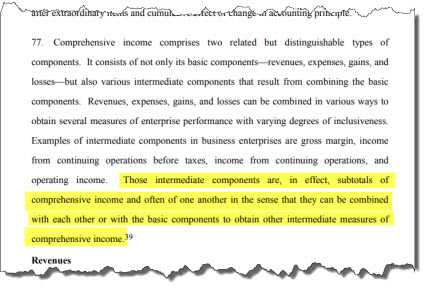The financial reports of economic entities creating using US GAAP, IFRS, and other such robust reporting schemes includes variability.
This variability is an essential, characteristic trait of such reporting schemes and contributes to the richness, high-fidelity, and high-resolution of reported financial information. This variability is a feature of such reporting schemes.
Here is one example of such variability. The FASB discusses variability as it relates to US GAAP in the conceptual framework, specifically Statement of Financial Reporting Concepts No. 6. For example, on page 47, paragraph 77, you see:
That specific discussion relates to comprehensive income, but the same general idea applies to most aspects of a financial report.
As I said, this variability is not unique to the FASB and US GAAP, for example, if you look at IPSAS issued by the International Public Sector Standards Board you see the same ideas.
But "variability" does not mean "arbitrary" or "random". Variability must be managed and controlled to keep it within proper limits.
There are "clusters" of acceptable, standard ways to create financial reports, not just one way. I call these "clusters" by the term "pattern". Here are examples of some of those clusters:
- Reporting styles: The styles that companies use to report have clusters. I call these reporting styles. US GAAP has reporting styles, IFRS has reporting styles. Other reporting schemes likewise have clusters of reporting styles.
- Fundamental accounting concept relations: It may be the case that "Assets = Current Assets + Noncurrent Assets"; or it might be the case that "Assets = Current Assets + Fixed Assets + Other than Fixed Assets". There are many other such relations. You can measure these relations within financial reports.
- Disclosure Mechanics: Disclosures in a financial report are clustered. Not every company reports every possible disclosure, different companies might pick between different alternatives.
That is a good example of the variability within a financial report.
The Method of Implementing a Standard Digital Financial Report Using the XBRL Syntax is an approach to managing and controlling that variability. There are other approaches to managing therefore controlling variability. However, you cannot simply ignore the variability.
This method uses machine-readable business rules to "channel" and therefore control variability, keeping the variability within standard limits. That keeps quality where it needs to be. Rules enable things like preventing a user from using a concept meant to represent one thing from unintentionally being used to represent something different.
Managing variability is essential to representing the high-fidelity, high-resolution information that is contained in a financial report at the high-quality level necessary for such reports.
